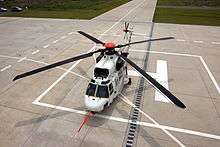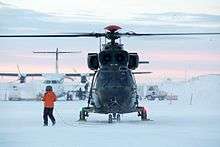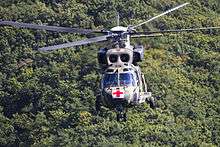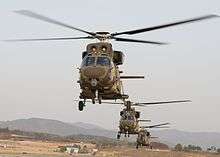KAI KUH-1 Surion
The KAI KUH-1 Surion is a twin-engine, transport utility helicopter developed primarily by Korea Aerospace Industries (KAI), Agency for Defense Development (ADD) and Korea Aerospace Research Institute (KARI) jointly with Eurocopter. In 2006, the research and development phase of the Korea Helicopter Project - Korea Utility Helicopter (KHP-KUH), costing around 1.3 trillion won ($1.2 billion), was launched by the Agency for Defense Development.[7][8] In 2012, full-scale production of the Surion commenced; KAI has been designated as the principal manufacturer of the type.[8]
| KUH-1 Surion | |
|---|---|
.jpg) | |
| Korean Utility Helicopter KUH-1 Surion | |
| Role | Medium transport helicopter |
| National origin | South Korea |
| Manufacturer | Korea Aerospace Industries |
| Designer | Korea Aerospace Industries (with technical assistance from Eurocopter)[1] |
| First flight | 10 March 2010[2] |
| Introduction | 22 May 2013[3] |
| Status | In service[4] |
| Primary users | Republic of Korea Army National Police Agency |
| Produced | 2010-present |
| Number built | 69[5] |
| Unit cost | |
| Developed from | Eurocopter EC725 |
An initial force of around 245 Surions have been ordered by the Republic of Korea Army to replace their aging fleets of UH-1H utility helicopters and 500MD light utility helicopters,[8] which have been in service for decades. KAI shall also construct civilian and law enforcement variants of the helicopter.[8]
In 2017, the Surion was the centerpiece of an embezzlement scandal involving parent company KAI, the South Korean Ministry of National Defense and its Defense Acquisition Program Administration.[9][10]
Development
Origins
In December 2005, the South Korean government appointed Eurocopter as the primary partner to KAI for the then-formative Korea Helicopter Project - Korea Utility Helicopter (KHP-KUH).[11] In June 2006, KAI and Eurocopter won the KHP-KUH 1.3 trillion-won ($1.2 billion) research and development contract from the Defense Acquisition Program Administration (DAPA) to start the project. It remains Seoul's biggest arms deal ever with a non-US company. The development of the aircraft was funded 84% by the South Korean government and 16% by Korea Aerospace Industries (KAI) and Eurocopter.[12][13] At the time, it was the biggest South Korean defense contract to be issued to a non-American defense company.[14]
A production contract worth about 4.4 trillion won ($4.3 billion) is expected to be signed around 2011 before the start of mass production. Eurocopter took a stake of 30 percent in the 2006-2012 development phase and 20 percent in the following ten-year production phase, KAI and the South Korean government held the remaining stakes in the program. As the prime sub-contractor, Eurocopter has provided technical assistance in part for developing the power transmission, main gearbox, boom and tail gearboxes, automatic flight control system and rotor mast.[8] Eurocopter experts were dispatched to KAI premises (Sacheon, South Korea) to provide support and teach KAI engineers state of the art processes and technologies for the design and manufacture of helicopters.[8]
.jpg)
In June 2008, KAI announced that the first prototype KUH was to be rolled in the following month and that ground tests would begin later that year; the firm also stated that it aimed to conduct the type's first flight in early 2010 and for the first production aircraft to be delivered in 2013.[15] In August 2009, the first prototype was unveiled by President Lee Myung-bak at an unveiling ceremony in Sacheon.[16] In October 2009, it was announced that the program was to be delayed as the result of several ministries having received reduced budgets as greater priority had been placed on social welfare programs; the Ministry of National Defense announced that stability of existing defense programs had been assured.[17]
On 10 March 2010, KAI announced that a prototype had performed the maiden flight of the Surion; two test pilots and an engineer had performed a series of taxiing and hovering maneuvers, as well as a stationary hover at 30 ft (9.1m), during this initial flight.[13][18] In May 2010, following three months of flight testing, the prototype performed its first public flight demonstration.[19] In January 2011, Eurocopter and KAI established a joint venture, KAI-EC, for the purposes of marketing the Surion and handling export sales; at the time, it was envisioned that 250-300 units would be sold worldwide by 2021.[11] In December 2012, deliveries of the first Surion model formally commenced.[20] In February 2013, low temperature testing in Alaska, United States, was completed, leading to development of the KUH-1 Surion being formally recognized as completed in the following month.[20]
Further development

The KUH-1 Surion served as the basis for a navalised derivative, the Korean Naval Helicopter (KNH). By 2011, the KNH had entered into the development stage; work was being performed on the project by a partnership between KAI, Eurocopter, and Elbit Systems.[11] In January 2016, following completion of development work on the amphibious variant of the Surion, it was announced that this variant had been cleared to enter production later that year.[21][22]
Various specialised models and derivatives of the KUH-1 have been proposed. In October 2009, KAI revealed that it was studying the potential for developing an indigenous attack helicopter based upon the KUH platform as one available option for meeting an established Korean Army requirement for a new attack helicopter (AH-X). This variant was reportedly to possibly share up to 70 per cent component commonality with the base KUH version.[23] In December 2015, the Korea Forest Service, the largest civil government helicopter operator, ordered a firefighting version of the KUH-1 Surion; this requires a special airworthiness certificate.[24]
In 2014, DAPA's Board of Audit and Inspection begun an investigation into the level of indigenous technology used on the Surion; the investigation revealed that the technology transfer arrangement with Airbus Helicopters only covered 134 out of the 450 components used in the rotorcraft's power delivery system amid allegations of a breach of contract, Airbus Helicopters responded that it had honoured the contractual terms.[14]
In October 2015, KAI announced plans to increase production of the Surion from one helicopter per month to three per month in 2016.[25]
Between 2011 and 2016, the National Aerospace Laboratory of the Netherlands conducted a technology demonstration program under contract from KAI of an experimental fly-by-wire flight control system for the Surion.[26]
KAI is offering the Surion to international markets for military and civilian purposes. In late 2013, it was reported that KAI had received requests for proposals regarding the Surion from two South American nations and another Asian nation; at the time, KAI stated that the company hoped to sell 60-120 over the following 15–20 years.[1] International marketing efforts are expected to escalate in 2017, as prior to this point the overwhelming priority had been to fully develop the Surion to conform with existing domestic requirements and roles. KAI has deliberately focused on marketing the type to countries in which previous export success had been found for the KAI T-50 Golden Eagle and KAI KT-1 Woongbi trainer aircraft.[25]
Design

The KAI KUH-1 Surion is a twin-engine medium-sized multipurpose rotorcraft, carrying up to nine troops along with a crew of four (two pilots and two gunners in the main cabin area) in a utility transport capacity. It has been designed to be rapidly reconfigured to serve different roles, some models are also navalised.[11] The Surion can perform various duties and roles, such as military transport, law enforcement, aerial observation, search and rescue, maritime support, aerial firefighting, and for civilian purposes along with other missions.[27][28]
Power is provided by a pair of 1,600 shp Hanwha Techwin T700-ST-701K turboshaft engines, a licence-built localized development of the General Electric T700.[29] The T700/701K, co-developed by General Electric and Hanwha Techwin, is the first rear-drive variant of the T700 engine and features a -701D common core, high-efficiency counter-rotating power turbine, and a new FADEC system.[30] The exhausts of the engines are equipped with large infrared suppressors; these have been adapted from those used on the Eurocopter EC725.[16] Airbus Helicopters manufactures various elements of the Surion's transmission;[31] the lower-than-intended level of indigenous production of these components has been a point of controversy.[14]
The Surion is equipped with various survivability and damage reduction features. Both the airframe and the cockpit have been made bulletproof against small arms fire. The airframe, tail rotor, and the rotor blades used on both the main and tail rotors are of a crashworthy construction; anti-explosion sealed fuel tanks are also used. The main gearbox is capable of flying for a limited period after suffering the loss of lubricating oil. Various electronic defensive measures are incorporated onto the Surion, such as a countermeasures dispenser system (CMDS), radar warning receiver (RWR), laser warning receiver (LWR).[28]
British firm Cobham plc provides navigation and communication equipment for the Surion.[32] Sandle Avionic's HeliTAWS multi-hazard avoidance system is installed on Surions in police service.[33] Elbit Systems of Israel produces the helmet mounted display (HMD) used on the Surion, the HMD allows the crew to conduct full day-and-night operations.[16]
Operational history

On 22 May 2013, a handover ceremony of ten Surions was conducted to mark the helicopter's deployment at the Army Aviation School in Nonsan, South Chungcheong Province, attended by President Park Geun-hye.[34][35]
The KUH-1 performed its first operational mission in August 2015, conducting MEDEVAC in the aftermath of North Korean artillery shells that struck South Korean territory near the Korean Demilitarized Zone.[25] Since entering service, the Surion has reportedly held an availability rate in excess of 80 percent.[25]
The Surion was grounded in July 2016 in response to the CHC Helikopter Service Flight 241.[36] In late 2016, deliveries of the Surion were halted while a resolution for an icing issue that was discovered during winter testing was worked upon.[37]
On July 27, 2017, it's reported that the Surion will undergo icing tests in a few months.[38]
On the 17th of July 2018 a South Korean MUH-1 Marineon crashed when its main rotor detached killing 5 and seriously injuring 1, it also burst into flames on impact after the small 10m fall while it was supposedly engineered to withstand falls from much greater heights before combusting.[39][40]
The UH-1H helicopter was retired from South Korean Army service in July 2020 after 52 years of operation, replaced by the Surion.[41]
Variants

.jpg)
The following variants were planned by KAI aside from the manufacture of the Surion.[7]
- KUH-1 Surion
- The basic military utility helicopter used by the Republic of Korea Army.
- KUH-Medevac
- A medical evacuation variant.[42] It is equipped with a hoist for lifting patients, a weather radar, a detachable auxiliary fuel tank, a traffic collision avoidance system, medical equipment to treat six patients, and additional communications. First flight occurred on 25 January 2016 and will be delivered in 2018.[43][44]
- MUH-1 Marineon
- A land- and sea-based amphibious variant for the Republic of Korea Marine Corps, it has a 96 percent part commonality with the Surion. Modifications include an integrated flotation system, auxiliary fuel tank, and specialised radio equipment.[45] The Marine Surion first flew on 19 January 2015; It also has a folding main rotor to serve aboard Dokdo-class amphibious assault ships.[46] In December 2016, KAI secured a contract to deliver 30 Surions to the Marine Corps,[5] with the first two delivered in January 2018.[47]
- KUH-ASW (Anti-Submarine Warfare)
- A naval variant[48] equipped with torpedoes and anti-ship missiles.[25]
- KUH-1P Chamsuri
- Korean Police version (KUH-1P/ Chamsuri) - Surion utility helicopter chosen by the Korean National Police Agency (KNPA) for its Police Helicopter Project.[49] Equipped with a weather radar, traffic collision avoidance system, inertial navigation system, and an external hoist and cameras for rescue duties (extra electronics are needed compared to ordinary police helicopters for operations near North Korea, which frequently conducts jamming operations).[50]
Operators
- Republic of Korea Army: 245 KUH-1 Surions on order. The deliveries, which started in 2012, will take for eight to ten years.[51] 62 in service as of December 2016.[5]
- Republic of Korea Marine Corps: 30 amphibious variant ordered.[5]
- National Police Agency: 2 KUH-1P aircraft ordered, both delivered by 12 February 2014.[52] In December 2013, KAI received an additional order from National Police Agency.[53] A third will be added in late 2015, and a fourth in 2017.[50]
- Korea Forest Service: Korea Aerospace Industries (KAI) has been awarded a contract by the Korea Public Procurement Service to provide a KUH Surion helicopter to the Korea Forest Service (KFS), the company announced on 7 December 2015. The service's Surion will be delivered by the end of 2017 and fitted with a 528-gal (2,000-l) water tank and a rescue hoist.[54]
- Jeju Fire Department: Contract to provide a fire-fighting helicopter for Jeju Fire Safety Headquarters. The 25-billion-won helicopter will likely be launched in 2018.[55]
- Korean Aerospace Industries: The company itself operates four prototype units and one export version helicopter.[5][56]
Accidents and incidents
- In July 2018, a MUH-1 Marineon crashed at Pohang Airport, South Korea killing 5 crewmembers and injuring one fire fighter. The helicopter was on a test flight when it went down at a height of 10m and caught fire. A committee will be formed to determine the exact cause of the crash, however the mechanical failure is obvious as the main rotor had separated from the aircraft during take-off.[57][58][59]
Specifications
Data from Militaryfactory.com[60]
General characteristics
- Crew: 2 pilots + 2 gunners(crews) + 9 troops, or 2 pilots + 15 passengers
- Capacity: 17
- Length: 19.0 m (with main Rotor), 15.09 m (without Rotor) (62.3 ft, 49.5 ft)
- Rotor diameter: 15.8 m, tail 3.15 m (51.8 ft, 11.5 ft)
- Height: 4.5 m (14.8 ft)
- Empty weight: 5,136 kg (11,324 lb) (11,323 lb)
- Useful load: 3,753 kg (8,274 lb)
- Max. takeoff weight: 8,709 kg (19,200 lb)
- Powerplant: 2 × Hanwha Techwin General Electric T700/701K (T700-GE-701C variant) turboshaft, max. 1,915 shp (max. 1,915 shp[61]) each
Performance
- Cruise speed: 283 km/h (153 kts)
- Never exceed speed: 290 km/h (157 kts)
- Service ceiling: 4,595 m (15,075 ft) ()
- Rate of climb: 8.5 m/s (Vertical rate of Climb 1,700 ft/min)
- Hovering ceiling: 2,717 m (8,915 ft)[62]
Armament
- Missiles: (planned in development) Air to ground missile
Avionics
GPS, INS, Radar, Digital Map, FLIR(EO/IR), TCAS II, HTAWS, ELT, AIS, HUMS, IRS, EWC, MWR, LWR, RWR, CMDS, OBIGGS, etc.
See also
| External video | |
|---|---|
Related development
Aircraft of comparable role, configuration and era
Related lists
- List of rotorcraft
- List of utility helicopters
References
- Waldron, Greg. "KAI eyes export market for Surion." Flightglobal.com, 30 October 2013.
- Kwon, Kyongsong (29 March 2013). "South Korea's Utility Helo Makes Maiden Flight". Korea News. hankooki.com. Archived from the original on 23 July 2012.
- Army deploys Surion copters. koreatimes.co.kr, 22 May 2013.
- Jung, Sung-ki (11 March 2010). "South Korea's KAI Surion finishes development". Defence News. Army Times Publishing Company. Archived from the original on 6 April 2013.
- KAI secures deal for 30 amphibious Surions - Flightglobal.com, 30 December 2016
- http://www.etnews.com/201305220557 "최초 국산헬기 '수리온(KUH-1)' 첫 실전배치까지, 얼마야?" 22 March 2013. Retrieved: 05 August 2014.
- Wendell Minnick and Jung Sung-Ki (23 October 2009). "S. Korea's Defense Industry Shows Progress at Show". Defense News.
- "KAI and Eurocopter reveal the Surion". Shepard. 2009-07-31. Archived from the original on 2010-03-15. Retrieved 2010-04-12.
- Park, Hyong-ki (18 July 2017). "Korea Aerospace Industries hammered amid scandal". koreatimes.co.kr. Korea Times. Retrieved 11 May 2018.
Auditors found that the state-run Defense Acquisition Program Administration (DAPA) has been covering up a number of defects with KAI's Surion chopper, including problems with its engine and lightning protection.
- Yeo, Jun-suk (21 September 2018). "KAI vice president found dead amid corruption scandal". koreaherald.com. Korea Herald. Retrieved 11 May 2018.
One of the allegations facing Ha is that that the company made at least 24 billion won ($21.3 million) in illicit profits by inflating development costs for Surion utility helicopters, T-50 supersonic trainer jets and FA-50 light attack planes.
- "Eurocopter reinforces its commitment to strengthen the Republic of Korea's aerospace industry, and highlights the Surion and its naval derivative." Vertical, 19 October 2011.
- "한국형 기동헬기 실물모형 공개". donga.com. 15 October 2007. Archived from the original on 20 August 2014.
- Donald, David. "Korea's Surion Helicopter Flies." AIN Online, 15 March 2010.
- "Local helicopter manufacturing is expensive flop." Korea JoongAng Daily, 22 December 2014.
- Govindasamy, Siva. "PARIS AIR SHOW: Korea Aerospace to roll out utility helicopter prototype in July." Flight International, 14 June 2009.
- "Surion: Eurocopter's Korean KHP/KUH Helicopter Deal". Defense Industry Daily. 4 August 2009.
- Siva Govindasamy (1 October 2009). "South Korea to delay indigenous fighter, attack helicopter programmes". Flight International.
- Francis, Leithan. "PICTURES: Korea Utility Helicopter makes first flight." Flight International, 16 March 2010.
- "Korea Utility Helicopter demonstrates capabilities." Korea Times, 22 May 2010.
- "History." KAI, Retrieved: 23 June 2016.
- Perrett, Bradley."Marines Version OF KAI Surion Ready For Production." Aviation Week, 5 January 2016.
- Maass, Ryan. "KAI completes Surion-variant helicopter development." United Press International, 29 December 2015.
- Govindasamy, Siva. "KAI reveals options for army attack helicopter." Flight International, 21 October 2009.
- "South Korea Forestry Service Orders Surion; Russia Protests." Aviation Today, 1 December 2015.
- KAI readies to boost Surion production in 2016 - Flightglobal.com, 23 October 2015
- "KAI's Surion Fly-By-Wire flight control system successfully tested." National Aerospace Laboratory, 7 April 2016.
- Donald, David. "Eurosatory 2016: Versatile lifter [ES2016D5]." IHS Jane's 360, 17 June 2016.
- "KUH-SURION." KAI, Retrieved: 22 June 2016.
- "Turboshaft Power Supporting Global Markets and Missions". aviation.ca. 9 July 2006.
- "GE's T700 Engines To Power Korean Helicopter Program (KHP)". GE aviation.com. 19 July 2006.
- "History: From Eurocopter to Airbus Helicopters." Airbus Helicopters, Retrieved: 22 June 2016.
- Waldron, Greg. "Cobham to supply antennas and avionics for KUH." Flight International, 22 December 2010.
- Waldron, Greg. "Sandel Avionics to provide avoidance system for S Korea police's Surions." Flight International, 20 June 2012.
- "President marks deployment of Korea's 1st military chopper." Korea.net, 23 May 2013.
- Seung-woo, Kang (22 May 2013). "Army deploys Surion Copters". Korea Times.
- "H225 crisis grounds South Korea's Surion". Flight International. 8 July 2016.
- Waldron, Greg. "Korea's Surion beset by icing issue amid gearbox grounding." Flight International, 30 September 2016.
- "'Surion' chopper to take anti-icing test again". 2017-07-26.
- "Dramatic footage shows the moment a crash of South Korean military helicopter - Defence Blog". defence-blog.com. 2018-07-18.
- "South Korean military helicopter crash kills five, injures one".
- Army's UH-1H choppers retired after 52 years of service. The Korea Herald. 27 July 2020.
- "Gov't taps KAI to develop medevac choppers for S. Korean Army". yonhapnews.co.kr. 2014-08-03. Retrieved 2014-08-05.
- Waldron, Greg. "PICTURE: Medevac Surion conducts maiden flight." Flightglobal.com, 28 January 2016.
- "Medical transport variant of KAI's Surion helicopter performed its maiden flight." Airrecognition.com, 25 January 2016.
- "KAI to develop amphibious assault variant of Surion." Flightglobal.com, 18 April 18, 2013.
- "PICTURES: Amphibious assault Surion makes maiden flight." Flightglobal.com, 23 January 2015.
- South Korea's Marine Corps receives first two MUH-1 Marineon choppers - Airrecognition.com, 10 January 2018
- "KAI, Eurocopter propose naval variant of Surion". flightglobal.com. 2011-10-24. Retrieved 2014-08-05.
- "KAI Surion chosen to replace Korean police helicopters". shephardmedia.com. Retrieved 2014-08-05.
- "South Korea buys a 4th Surion helicopter for law enforcement missions." Airrecognition.com, 21 October 2015.
- "KAI secures $1.6bn Surion helicopter contract". army-technology.com. 2013-12-22. Retrieved 2014-08-05.
- "국산 헬리콥터 '수리온' 경찰에서 임무 수행". yonhapnews. 2014-02-11. Retrieved 2014-07-17.
- "2013년 12월, KAI에 어떤 일이 있었나?". KAI blog. Archived from the original on 2015-03-11. Retrieved 2015-03-11.
- "Surion chopper to be used by Korea forestry service". koreaherald. 2015-12-07. Retrieved 2017-12-08.
- "Jeju to get its first multipurpose firefighting helicopter". kctvjeju.com. Archived from the original on 2016-06-04. Retrieved 2016-05-04.
- https://www.defensenews.com/industry/2019/10/17/see-kai-unveil-a-new-export-version-of-the-surion-helo-following-a-fatal-crash-last-year/
- ARIRANG NEWS (18 July 2018). "Footage released of deadly marine corps helicopter crash" – via YouTube.
- "Five killed in South Korean helicopter crash - Jane's 360". www.janes.com.
- "Five Killed, One Injured in South Korea Helicopter Crash". www.defenseworld.net.
- KAI KUH-1 Surion Medium-Lift Transport Helicopter (2013).militaryfactory.com.
- "T700-701K turboshaft engines" (PDF). geaviation.com. Archived from the original (PDF) on 2014-09-06. Retrieved 2014-09-06.
- "우리나라 최초 국산헬기 SURION(수리온) 모습 공개". koreaaero.com. Retrieved 2014-09-21.